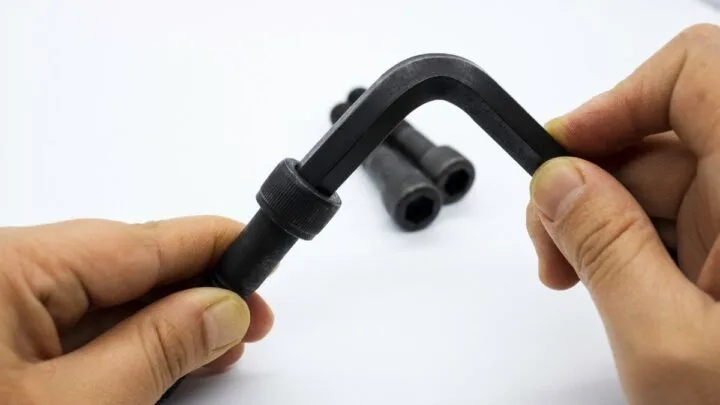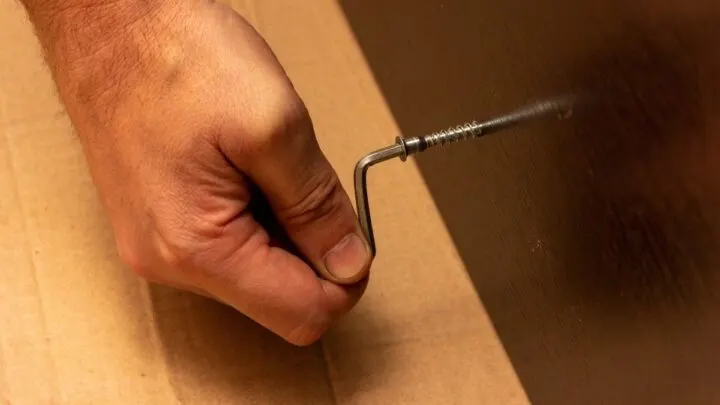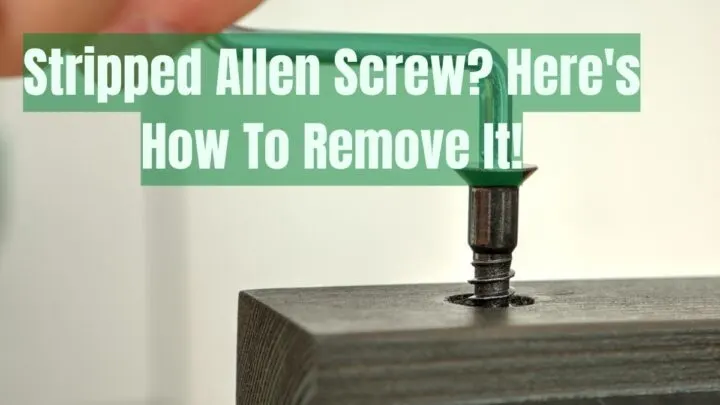Dealing with a stripped Allen screw can be incredibly frustrating when you are trying to get some work done, but how do you remove it?
Whether you are a professional mechanic, a hobbyist, or simply a homeowner looking to do some quick repairs around the house, from time to time, you run into a stripped Allen screw.
At first glance, the Allen screw may look like it is impossible to get out but by implementing some tried and true methods, you can have it out in no time.
To remove a stripped Allen screw, use a pair of pliers to create movement by rotating the screw’s head. If this does not work, try using a piece of cloth for grip and modify the indentation of the grooves with a flathead screwdriver or a screw extraction kit.
Allen screws are universal in mechanics and they are used across so many industries that you are bound to run into one sooner or later when handling repairs.
They are very reliable and easy to use – offering more torq than other options due to their hexagon shape.
But at a certain point, they can get a bit worn and torn. One of the most common issues that people run into with Allen screws is that they become stripped over time.
When this occurs, the grooves of the screw no longer have any grip and it will seem like it is impossible to remove.
A lot of people give up at this point and seek professional help, but you should be able to get the Allen screw out yourself right at home.
To help you understand this further, we are going to take a closer look at some of the methods that you can utilize to remove your stripped Allen screw.
After extensively researching Allen screws, I have been able to gather enough information to determine the best ways to remove them if they are stripped.
How Do Allen Screws Get Stripped?
If you are dealing with a stripped Allen screw, you are probably wondering how it got worn and torn in the first place.
Allen screws are tough and are designed to support furniture and even heavy-duty machinery, but if treated with disrespect and disregard, they can easily get stripped.
All it takes is one mistake when working with Allen screw to strip away its grooves and render it useless.
This is often the case when applying too much torque to the Allen screw – fastening it past its tightest point. More often than not, this occurs when you are not giving your work the attention that it deserves.
Mechanical parts demand our focus and we run into issues like stripped screws when we become distracted or absent-minded when working.
If you want to avoid removing stripped Allen screws in the future, treat your tools and mechanical parts with care and respect so that you can maximize their lifespan.
Give your Allen screws the right amount of torque and do not tighten more than you need to.

How to Remove a Stripped Allen Screw
Running into a stripped Allen screw is not the end of the world. If you can avoid it by properly using your tools in the first place, that is the best way to skip this entire process.
But you will find that even professional mechanics run into this issue periodically.
There are a number of different techniques and approaches that you can utilize to remedy the situation.
However, each one is going to be more appropriate for a specific type of condition and scenario, which is why you want to carefully assess your stripped Allen screw before trying to implement any of the approaches that we mention.
Let’s dive right into the different methods that you can utilize to remove a stripped Allen screw.
Pliers
If you can get the job done with pliers, this is the ultimate way to remove your stripped Allen screw quickly and efficiently.
The only way that you can remove the Allen screw with pliers is if you see that it is sticking out and exposed.
If there is even a tiny bit of space between the Allen screw and what it is fastened to, you should have enough room to get a grip with your pliers.
Grab your pliers and clamp them onto the head of the screw.
Once you feel that you have got a firm grip on the Allen screw, begin rotating the screw counterclockwise.
Always remember lefty loosey, righty tighty, as forgetting this simple saying is often what leads to stripped screws in the first place.
Continue to rotate until you feel the Allen screw start to move.
You want to use ample force as you do this to prevent the screw head from breaking, which can make the removal process a lot harder.
Once you have gone through a few rotations, the Allen screw should be loose enough so that you can unscrew the rest by hand.
Material Assistance
Depending on how badly stripped the screw is, you may be able to utilize a material such as rubber or a piece of cloth.
For this approach, you will need a flathead or a Philips-head screwdriver in combination with the material.
Place the material over the screw and then stick the screwdriver inside.
You need to use a screwdriver that is a similar size to your Allen screw.
With the material covering the screw and the screwdriver firmly inside, begin rotating.
If there are still some grooves left to provide traction for the screwdriver and material, you should be able to get movement in the Allen screw.
If it starts to budge, you will be able to remove the screw in the same way as in any other situation.

Modify the Indentation
If the grooves in your Allen screw are a lost cause, then the next best approach is to create new ones.
You will need another type of screwdriver (preferably a flathead) for this method, as well as a hammer.
What you want to do is replicate the point of the screwdriver inside of the Allen screw by using balanced force with the help of a hammer.
Stick the screwdriver into the Allen screw socket and then hit the other end of it with ample force to create an indentation.
We find that it is best to start light and then add force with each hit to create a precise indentation.
After a few strikes, take a look at the Allen screw socket to confirm the indentation.
Try to stick your screwdriver inside of the indentation you created to see if you can get enough grip to rotate the screw.
If you can rotate it, then you will be able to extract the Allen screw.
However, if you are having trouble getting it to grip, then you will need to repeat the process to create a better indentation.
Adhesive Substance
If you could not get the stripped screw out using conventional methods, you may want to consider using an adhesive substance that was designed for this kind of situation.
There are a number of products on the market that can assist your screw removal process with adhesive support.
This approach can only be utilized if your stripped screw still has some of its grooves intact. Each product is a bit different so read the instructions before you use it.
Generally speaking, most products will instruct you to add a few drops to the Allen screw socket. Stick your screwdriver inside, give it a minute to take hold, and then begin rotating your screwdriver.
Extraction Kit
Stripped screws are a common problem and to make life easier for all of us, screw extraction kits were created.
You should only utilize this method if you have already gone through all of the previous approaches that we mentioned, as it requires you to drill into the socket to change its form.
With that being said, a power drill will be a necessary tool for this procedure. Take an appropriate-sized bit from the screw extraction kit and attach it to your drill.
Stick it inside of the socket and engage your drill to create a new groove inside of the Allen screw.
Remove the drill and flip the bit over into its reverse position.
Once the new groove has been drilled, it will fit perfectly and you can remove the Allen screw by engaging your drill to rotate counterclockwise.
Summing Up Removing Stripped Allen Screws
It might seem difficult to remove a screw after it’s been stripped, but before you call the professionals, try out some of these tips.
You can try to get it out yourself first by using pliers, other materials, or adhesive substances specifically designed for this dilemma.
If all else fails, then it might be time to get some professional help, but these tips should do the trick!


